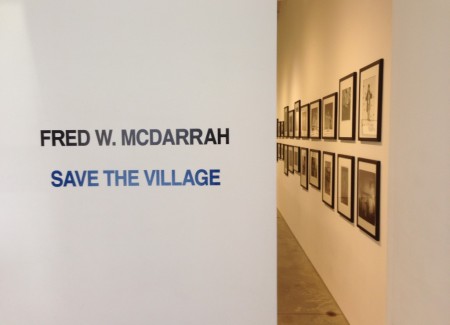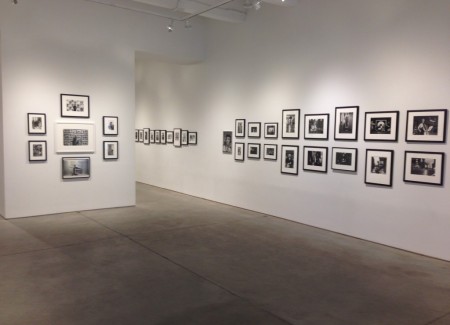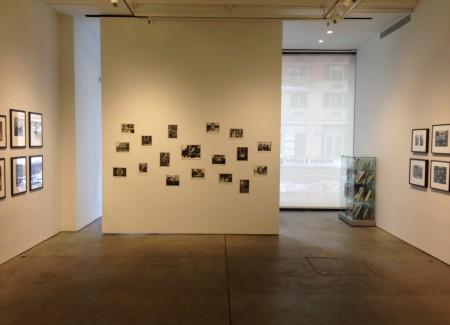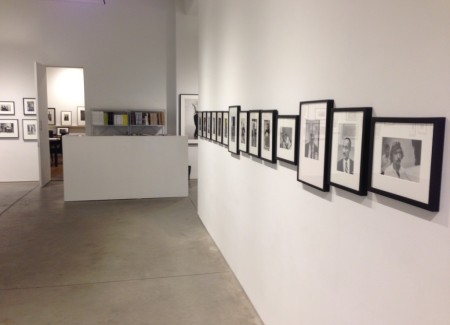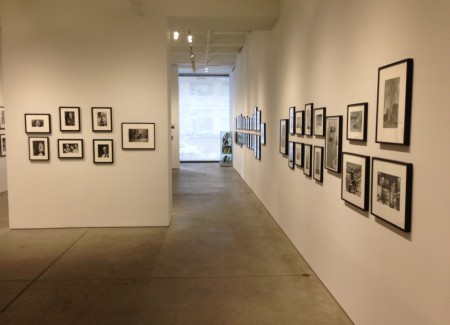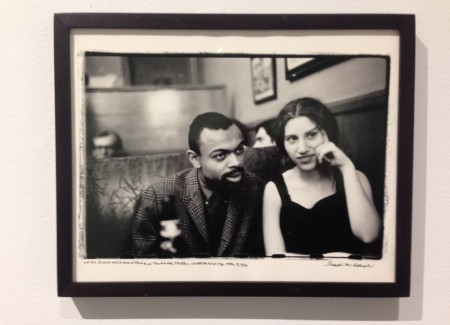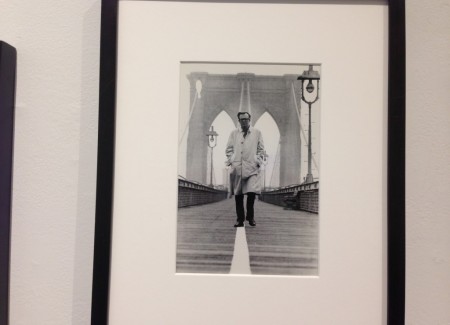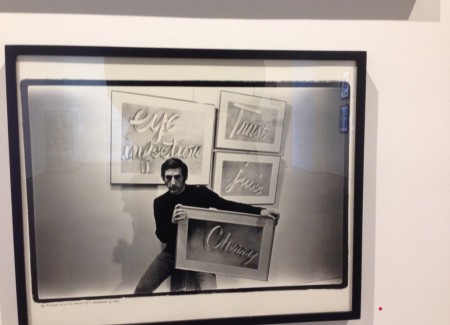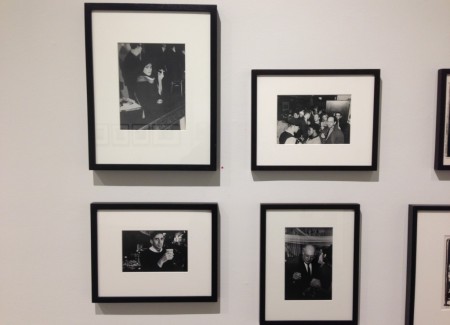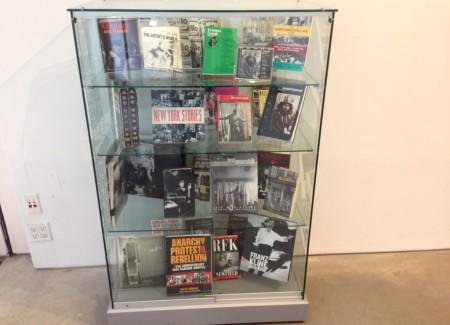JTF (just the facts): A total of 135 gelatin silver prints, mounted in white mats and displayed in either black or white wooden frames. The works are shown either in a single line or double-hung on all of the side walls of the main and side galleries, along with three walls of the two partitions. Print sizes vary from 7 x 6 inches to 16 x 20 inches, with the majority being either 8 x 10 inches or 11 x 14 inches. All the photographs were shot between 1958 and 1979 and are vintage. There is also a glass bookcase near the front window with a sample of the more than 30 books that used McDarrah’s pictures, either as inside illustrations for texts about the history of downtown New York’s music, art, and literary scenes, or as portraits for the jacket cover. (Installation shots below.)
Comments/Context: Fred McDarrah (1926-2007) was a press photographer with a difference, that difference being that he worked at the Village Voice. Beginning in the 1950s and for decades thereafter, he was the guy in the office–the Peter Parker–assigned to head out at any time of day or night and bring back news pictures for the next week’s edition. The job was not high-paying, but neither was it oppressive. Unlike his professional colleagues at the New York dailies, he didn’t have to negotiate with layers of upper management. Nor did his prints have to pass rigid codes of quality. In a sense McDarrah had only to satisfy himself because his other job was picture editor.
As his beat was downtown New York at a time when the city’s music, art and literary subterranean tributaries were becoming the world’s mainstream, McDarrah enjoyed unique opportunities. The chores of a news photographer might be the same everywhere: go someplace and take a picture of the person to illustrate someone else’s story. But stories for the Voice were not the usual ribbon cuttings or press conferences, assignments that kill brain cells in even the toughest newspaper pros. Nor did McDarrah have to photograph your typical garden club officials or civic notables.
New York politics in the 1960s, ‘70s, or ‘80s meant his subjects were Mayor John Lindsay, Bella Abzug, Congressman Ed Koch, Allard Lowenstein, William Kuntsler, Jerry Rubin, Robert Moses, Herman Badillo, Bess Myerson, and Robert Kennedy. These were the years of Women’s Liberation, the Weather Underground, Hippies and Yippies, and the Stonewall Riots.
There were as many artists and kinds of art to photograph (Franz Kline, Barnett Newman, Ad Reinhardt, Yayoi Kusama, Andy Warhol, Donald Judd, Ed Ruscha, Larry Bell) as there were musicians and kinds of music (Bob Dylan, Pete Seeger, Lamonte Young, Jimi Hendrix, John Cage, Phil Ochs.) Strapping on his camera for a night patrol around the clubs and lofts, McDarrah might find himself documenting a poetry reading by Jack Kerouac or Allen Ginsberg; or a performance by Julien Beck and the Living Theater, a topless cello recital by Charlotte Moorman, or a Happening with Claes Oldenburg at the Judson Church.
This sentimental show features all of these celebrities and more. They are grouped around the walls according to their various fields and much of the fun is seeing youthful versions of figures we know better as older, more solid citizens: photographer Bill Cunningham in 1971, his face tense and unlined, his hands holding his Leica as he peers out from behind McDarrah and his son; poet LeRoi Jones (before he became Amiri Baraka) smiling as if he were about to get lucky with fellow beat Diane di Prima as they are seated in a booth at the Cedar Taven in 1960; a nude and buff Charles Ludlum flexing his muscles in a body-builder’s pose in 1976; and a justifiably dazed Dustin Hoffman, standing on E. 11th St. on March 6, 1970, the day the building next door to him exploded from a Weather Underground homemade bomb.
Many of these photographs are distinguished mainly by the personage in the frame or the historic event recalled. Warhol’s Factory and late-night concerts by the Velvet Underground have been covered better by others.
But a couple of portraits are standouts: Susan Sontag at a Sex Symposium in 1962, her arm locked upright with cigarette extended, the pose calculated to look as if she has been caught in an unguarded moment; and Janet Malcolm in 1980, suited like a young Oscar Wilde (or a mature Fran Leibowitz) and regarding McDarrah (and no doubt us) with an assessing gaze.
McDarrah was not as stylish a chronicler of downtown New York as some of his predecessors–Berenice Abbott, Weegee, Rudy Buckhardt, John Cohen–or as his younger Village Voice colleague, Sylvia Plachy. His workmanlike pictures bespeak their origins as illustrations for stories.
But a participatory joy in the tawdry spectacle of downtown New York (such as it used to be) animates each frame. What other photographers were there for closing night of the Cedar Tavern March, 30 1965 and at demonstrations at the Stonewall Inn on June 29, 1969 Who else was lucky enough to make portraits of Hubert Selby crossing the Brooklyn Bridge and Jack Smith acting in an avant-garde film?
McDarrah’s stamina was remarkable. To paraphrase Woody Allen, eighty-percent of being a successful photojournalist is showing up. But the other twenty-percent is heart. McDarrah’s range of empathies is admirable for his or any time. The Voice was lucky to have him and vice versa. Documentary work in a neighborhood over this breadth of time is unlikely to be supported again by a commercial enterprise.
Collector’s POV: Most of the prints are on sale for $2500 or $3000, with portraits of a few specific celebrities (Bob Dylan, Allen Ginsberg, Andy Warhol) available between $7000 and $10000. McDarrah’s work has little secondary market history, so gallery retail remains the best option for those collectors interested in following up.
